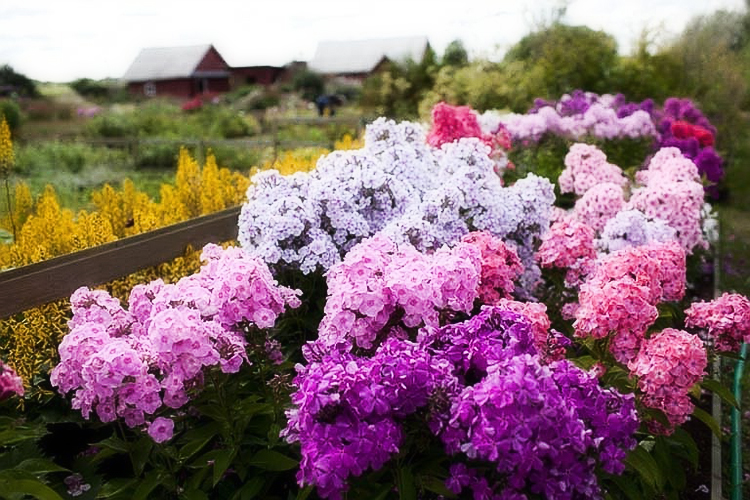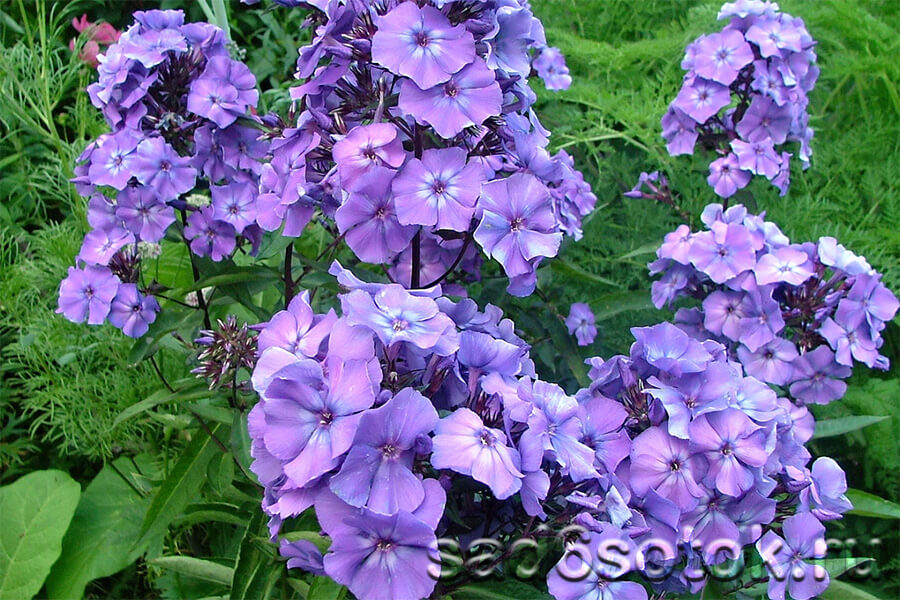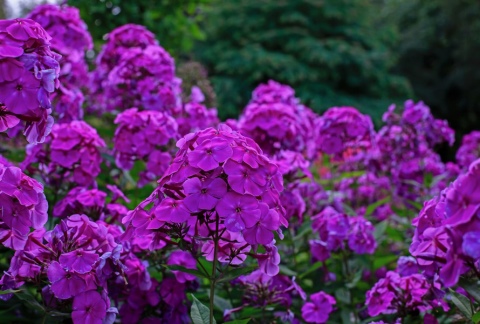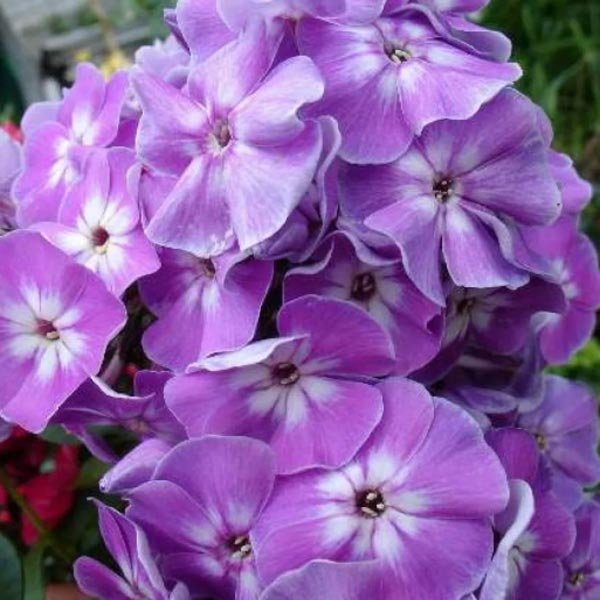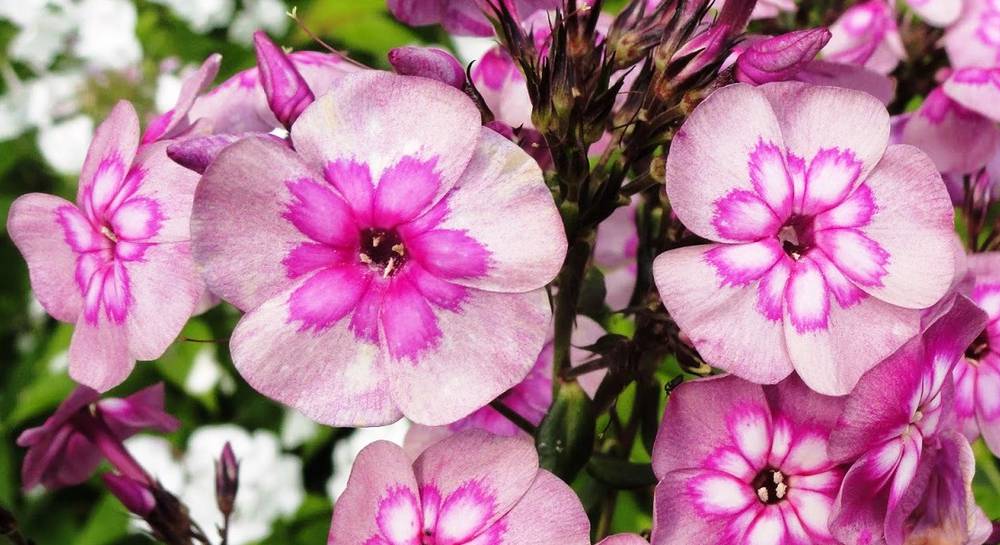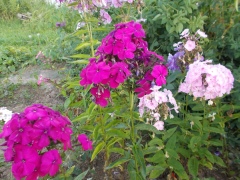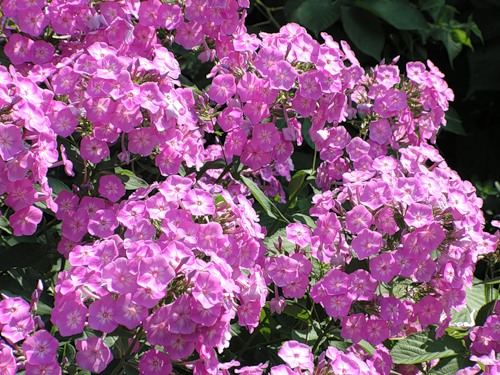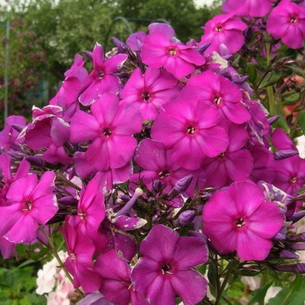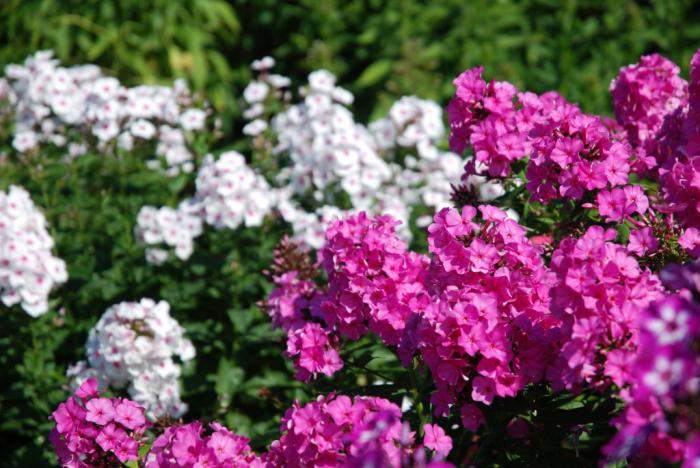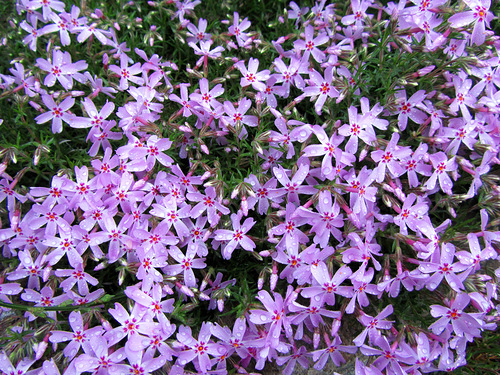Planting rules for perennial phlox
 "Claudia Shulzhenko"
"Claudia Shulzhenko"
The most popular type of phlox is paniculata. This is an unpretentious plant, however, providing favorable conditions will have a good effect on the duration, abundance of flowering and on the condition of the bush as a whole.
Seat selection
Before you start planting perennial phlox, you need to carefully choose a place where they will grow for the next years. This choice determines how well and quickly the flowers take root, adapt to the new environment, how soon they will bloom and how much additional care they need.
When choosing, one should be guided by the following factors:
- Stagnation of water at the root system negatively affects the condition of phloxes, so lowlands are not suitable for them. It is better to make the flower bed raised.
- At the same time, phloxes are moisture-loving plants, so plantings should be protected from drafts and strong winds, which quickly dry out the soil.
- Perennial phloxes are very photophilous, they prefer sunny places, the maximum is light shading at noon. In the shade, the flowering becomes less lush.
It is also important to consider that birches, spruces and lilacs will be bad neighbors for phlox. These plants have a powerful root system that will drown out phlox roots.
Soil selection and preparation
In order for perennial phloxes to please with lush and long flowering, it is advisable to prepare the soil for planting them a year before:
- The soil is well fertilized to the depth of the shovel bayonet. It is better to use rotted organic fertilizers, fresh manure will not work for these purposes;
- Phloxes prefer loose soil, therefore, sand, humus, turfy soil (for sandy soils) are added to heavy (clayey or loamy) soils;
- For growing phlox, neutral or slightly acidic soil is better. If the soil is too acidic, lime is added to it (200 grams per 1 m2).
You can also add mineral fertilizers to the soil so that the flower bed has enough nutrients for several years. Potash fertilizers can increase the frost resistance of phlox.
Planting and breeding
Perennial phlox grows quickly, so the most common and easiest way to reproduce them is by dividing the bush. This work is carried out in early spring or autumn (no later than mid-September):
- The bush is carefully dug out of the ground.
- Using a shovel or a sharp knife, the plant is divided into several parts (delenki). Each part should have 2-5 buds.
- Each part is planted in prepared holes at a distance of 30-35 cm. The holes should be shallow.
- When planting, the roots are straightened, sprinkled with earth. The upper roots should be 1 cm deep.
- After planting, the land is compacted and watered.
It is better to carry out all planting work in cloudy weather or in the evening, so that the strong sun does not destroy the plants. The first few weeks after transplanting, phloxes need additional care and abundant watering.
If you need to propagate a large number of plants, you can use the cuttings method. Cuttings are harvested from April to September, choosing healthy plants. Spring cuttings in the fall are transplanted into pots and stored in a basement or other place with a temperature of no higher than 5-6 degrees. In early February, the temperature is raised to +10 and the soil moisture level is kept constant. In March, shoots that have reached a length of 10 cm are cut into cuttings and planted in a flower bed, at a distance of 3-5 cm.
Phlox can also be propagated by seeds harvested after flowering, but before the seed pods open. They are sown in the ground from September to November, and in spring, shoots emerge from the strongest seeds.In May, they are transplanted to a permanent place.
Description
Phlox "Tatiana" - perennial, belongs to the group of paniculate phlox. Tall compact bush, grows within 80-90 cm. Stems are straight, dark green leaves - in the form of an elongated oval.
From the moment the first flowers appear, new buds bloom weekly. Their white-pink color is very delicate. In the center, at the base, there is a crimson ring that enhances the charm.
The sweetish aroma of phlox is attractive to bees and butterflies, which flock to feast on nectar during the period of abundant flowering. After the end of the flowering period, seed pods appear. The variety is frost-resistant and rarely susceptible to disease.

Diseases to which phlox are susceptible
Phlox paniculata is also susceptible to some diseases. Planting and care, chosen correctly, can reduce the risk of contamination of plants with pathogenic bacteria, but this cannot completely eliminate the risk.
Powdery mildew on phlox leaves
- Rust. It appears in the middle of summer. On the leaves and stem of the plant, red-brown spots similar to rust are observed. Subsequently, the number of spots increases, and the leaves are completely covered with them, the plant sheds the affected foliage, starting from the bottom, until it is completely bare. The fight against the disease is carried out by spraying the bushes and the soil around them with Bordeaux liquid and a solution of ferrous sulfate.
- Fomoz. This disease can be recognized by the presence of brown spots on the stem of the plant, which subsequently become loose and crust over and crack. Leaves turn yellow, dry out and fall off. Most often, plants are infected in the second and third years of life. Treatment of this disease practically does not bring success and it is better to remove infected plants, and take cuttings and planting material only from healthy phlox.
- Variegatedness. The most common disease among all phlox varieties. It appears at the moment when the plants begin to bloom actively. The disease can be identified by the presence of light-colored radial stripes chaotically covering the petals. The carriers of the causative agents of the disease are most often nematodes and other insects that feed on plant sap. If symptoms are found, phlox should be immediately dug up and burned, and the place where it grew should be disinfected.
Phlox infested with bedbugs
The main insect pests of phlox are nematodes, thrips and slugs. In the fight against them, it is necessary to treat both the plants and the soil under them at the planting stage. When dealing with slugs, it is best to use tobacco dust or wood ash.
Most popular types
Phlox paniculata has many hybrid varieties: monochromatic, multi-colored, simple, double, tall and dwarf.
Phlox dwarf
This species includes subulate phlox. Its growth is from 5 to 15 cm. The stem branches well and spreads over the surface resembling a flowering carpet. The leaves are sharp, thin, leathery. The species is characterized by muted pastel colors: pale blue, lilac, pink, mauve. Low-growing phloxes begin to bloom in May-June, filling the garden with a delicate aroma. The species is often used to decorate garden paths, small flower beds and are planted in pots, flowerpots, and portable tubs. It lends itself to cutting and does not lose its decorative effect with careful care and watering.
The representatives of the undersized include the following varieties:
Phlox Douglas. Growth no more than 5 cm. Leaves are gray-green, narrow. Flowers - pink, blue, lavender, white. Blooms 2 times during the summer, in early summer - May-June and August. One of the best varieties for making a living carpet.
Creeping phlox. The variety belongs to early flowering dwarfs, the height of its bush does not exceed 20 cm. The stem is branched, the inflorescences are umbrella-shaped, bright - pink, purple, purple, red. It blooms brightly and densely.
Medium phlox
Plant height reaches from 15 to 40 cm.Varieties tend to bloom in early summer May-June. The shape of the flowers resembles a violet or lilac, fragrant and bright, characteristic colors: bright pink, lilac, lilac, lilac-blue, white. The most common varieties: Canadian phlox, stolonosny phlox, wide-spread phlox.
Alyonushka. The variety is resistant to diseases and frost. The height of the bush reaches 50 cm, blooms in June for more than 30 days with pale pink flowers. The diameter of the inflorescence is from 14 to 16 cm, the diameter of the flower is 4 cm. Care and watering are moderate.
Snow White. A bush up to 80 cm high fits perfectly into any design of a flower bed and site. Its lush snow-white flowers will adorn any garden, blooming from July to August. The plant is resistant to diseases and fungi.
Tall phlox
This type includes the following varieties:
West. The plant grows up to 150 cm. It blooms with bright crimson flowers up to 2 cm in diameter. During the flowering period, the inflorescence is densely covered with flowers and seems to be burning with bright flowers.
Ural tales. It has an unusual color, the flower itself is dark pink with a red or purple center and white veins. The petals are slightly curled and look up. The height of the bush is 90-100 cm. It blooms in July-August. The variety is very popular.
Biological features
The flower got its name in Greece, where it was associated with flame. The fact is that the "progenitors" of modern phloxes were distinguished by their bright red color.
Over the years, in the process of hybridization and selection, new varieties of the most unexpected flower shapes and shades have been bred (and continue to be bred). There are no yellow ones yet.
Phlox paniculata is a perennial herbaceous flower, the height of which is up to 150 cm. A powerful root system is the basis of the plant's life and a guarantee that it will decorate your garden for years.
Compared to lush inflorescences that are located on fragile stems, phlox leaves look small, their shape is oval or lanceolate-elongated
The plant attracts attention and is remembered for its rich inflorescences of bright color. Flowers exude a pleasant aroma
If you combine the varieties correctly, the period when paniculate phlox blooms in your garden will be all summer and autumn.
The flowering time of one flower is 7 days. And in the inflorescence there are several dozen of them.
No less popular are such types of phlox as subulate and splayed.
After the end of flowering, the aerial part of the plant dies off. Simultaneously with this process, buds are laid in the ground, from which a new bush will appear next year, and every year it will expand.
Diseases and pests
If the conditions of agricultural technology are not followed, plants may encounter fungal diseases and parasites. Most often, Drummond phloxes are affected by one of the following problems.
- Powdery mildew - manifests itself as a white bloom on the leaves. To revive the plant, you can use activated carbon, crushed wood ash, or treat the culture with fungicidal preparations, for example, "Strobe" or "Alirin-B".
- Root rot - in this case, the stems begin to soften and turn black, brown spots appear on the leaves, and mold forms on the ground around the bush. This plant cannot be reanimated, it must be dug up, and the soil must be treated with copper sulfate. For the prevention of root rot, even at the time of moving the bush into the ground, enterobacterin or Trichodermin is introduced into the hole.
- Thrips - appear as yellowish spots on stems and leaves. The bush is deformed, and the leaf plates from the seamy side turn gray. In order to cure the plant, the ground around it must be treated with "Aktara" or a decoction of garlic. All damaged parts must be cut off to prevent the development of the disease.
- Spider mite. The pest itself is invisible, but you can guess about the defeat by it by the whitish fine cobweb on the inflorescences and leaves. For the treatment of plants used "Aktofit" and "Kleschevit".




Planting and caring for annual phlox
When to plant phlox In May, when it gets really warm, it is time to plant flower seedlings in flower beds, lawns. That is, open space. Phloxes do not like to be crowded, so the distance between young plants should not be less than 15 cm. Snapdragons and bells are often planted next to them. This flower arrangement is considered traditional, but many gardeners do not like it.
Care. In order for the phlox to bloom all summer and until late autumn, you need to adhere to simple requirements for the watering regime, plant feeding, and also regularly loosen the soil. It is no coincidence that in the first place there is sufficient, systematic watering, since this plant, due to overheating of the root system, does not tolerate drought at all. That's why:
- the soil needs to be mulched with something;
- after each watering, the soil should be loosened (not to a great depth, due to the close location of the roots to the surface of the earth);
- to improve flowering in the summer, you will need 4 top dressing: at the end of spring - liquid manure; first half of June - manure + superphosphate; a month later - liquid manure; end of July - potassium salt + phosphorus.
Important: proper care increases the resistance of flowers to major diseases: variegation, powdery mildew, foleosis, septoria.
When different types of phlox bloom
In breeding practice, the direction of breeding undersized phlox with a bush height of no more than 30 cm is actively developing. They grow in width and are well suited for arranging alpine slides. This species is called ground cover, and its most famous representative is the perennial phlox "Subulate".
It begins to bloom in mid-May, when other plants in the garden are still budding. Its flowers of white, pink, lilac color must be cut off immediately after they have faded, so that next year the phlox is even more beautiful.
At the end of May, representatives of the variety "Douglas" and purple-blue "Rucelli" bloom.
The next, after the ground cover, the loose varieties begin to bloom. So, when the weather is favorable in the last weeks of May, the “Spread” phlox with flowers of white, violet, and lilac colors blooms. They will delight you with their beauty for a whole month.
And one more beautiful flower of the loose-hearted variety - "Stolon-bearing". Growing rapidly, it covers the soil like a white, pink or blue carpet. This plant tolerates darkening and dampness well.
Flowering periods of popular phlox varieties:
| Variety | Flowering period |
| Landhochzeit | July August |
| Wenn schon denn schon | July - September |
| Prospero | Aug. Sept |
| Kirmeslander | Aug. Sept |
Peculiarities
Phlox paniculata is a perennial flowering culture. It is distinguished by a strong stem that lignifies before the onset of winter. The flower forms an upright bush, keeps its shape well. Many varieties of this group grow up to 100-150 cm, but there are also mini-variants that reach a small height (from 35-40 cm).
Earlier this culture was called "Torch". The fact is that initially there was only one of its colors - deep red. However, the works of breeders bore fruit and many different varieties of other shades were born. Snow-white, sky-blue, soft and bright pink, scarlet, purple flowers delight gardeners, transforming areas. There are only yellow tones in the palette of paniculate phloxes. There are also two-tone varieties. Combinations can be both gentle and contrasting, which allows widespread use of culture in landscape design.
The buds form spherical inflorescences. The flowers look like funnels, each consisting of 5 petals. The leaves are elongated. The root system of the plant is fibrous, large. Moreover, every year it increases in volume. She endures winter staunchly, in contrast to the aboveground part, which dies off. Since the roots can rise above the ground due to the increase in size, a little soil should be poured under the bush every spring.This will help the plant thrive and bloom beautifully.
Phloxes of this group bloom at different times, it all depends on the specific variety. This allows you to collect several varieties of crops on the site and enjoy lush flowering all summer. Interestingly, the buds open gradually. In all its glory, flowers appear before gardeners only in the second week of flowering. The pleasant scent of phlox is also worth mentioning.


